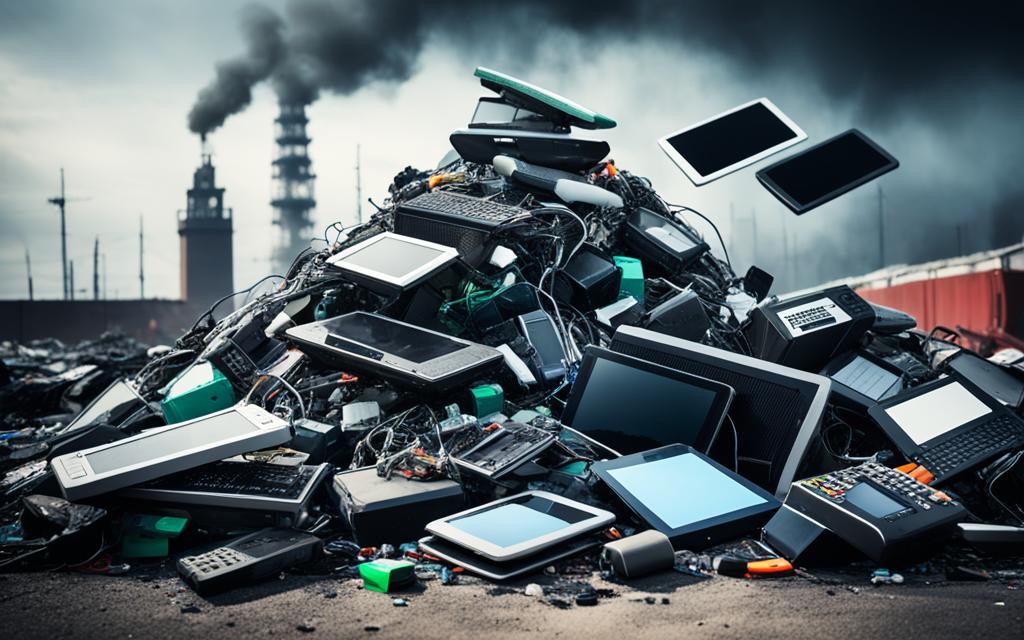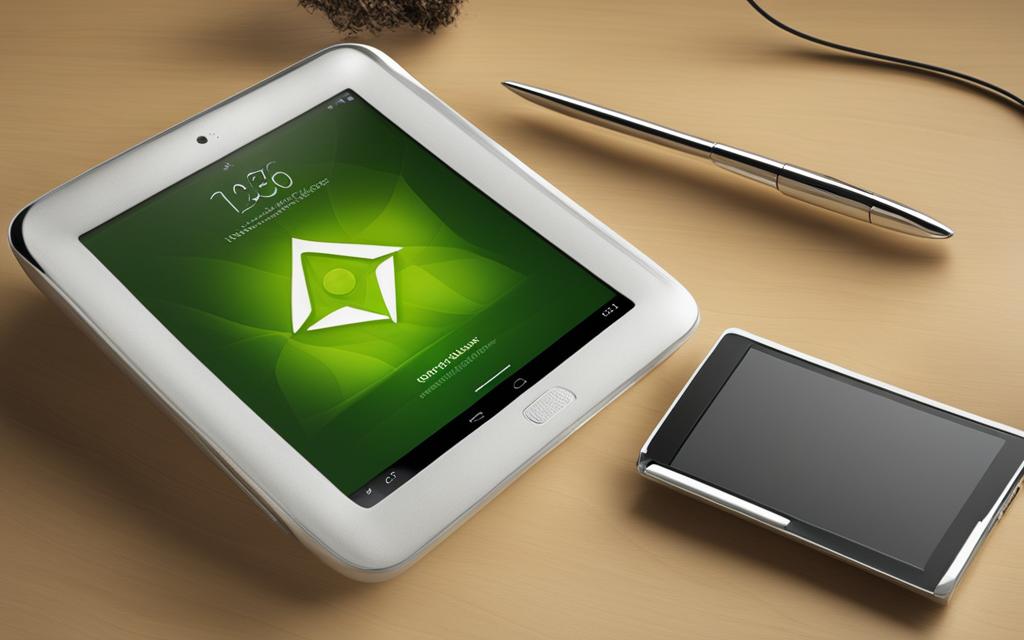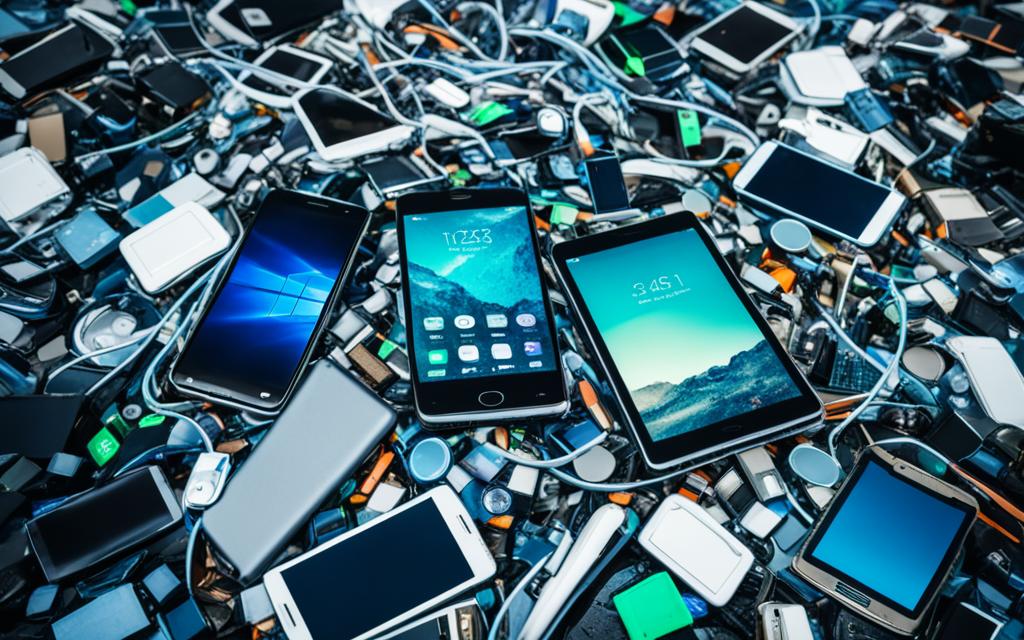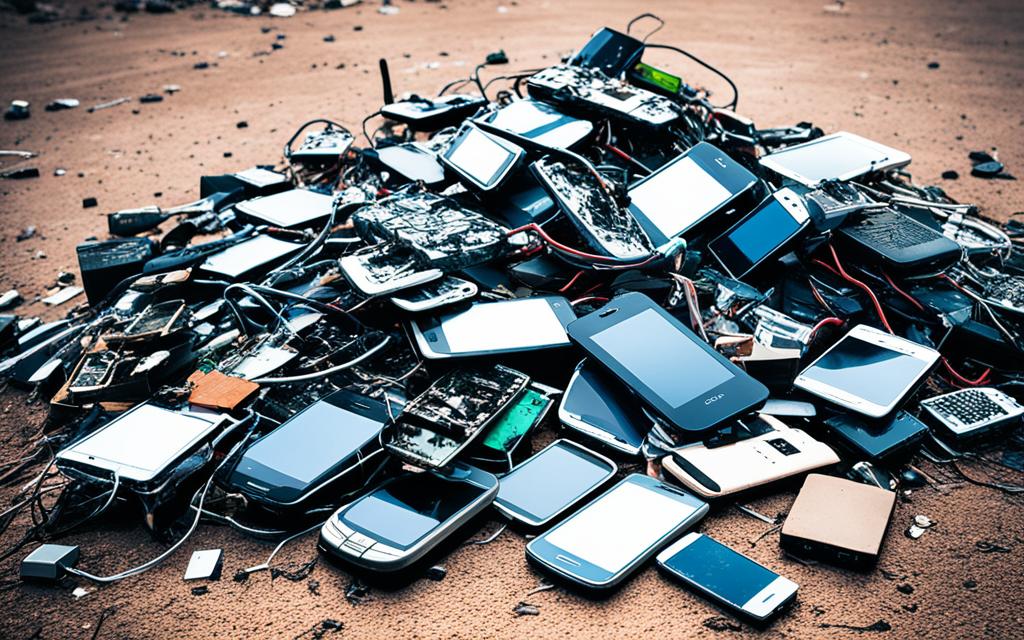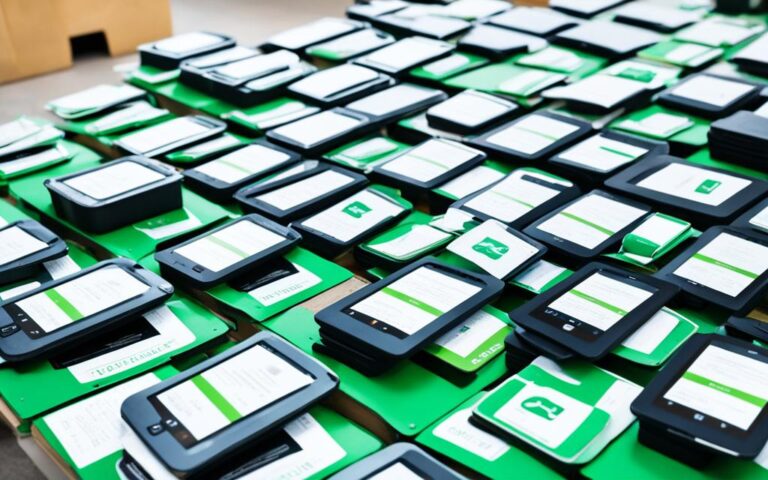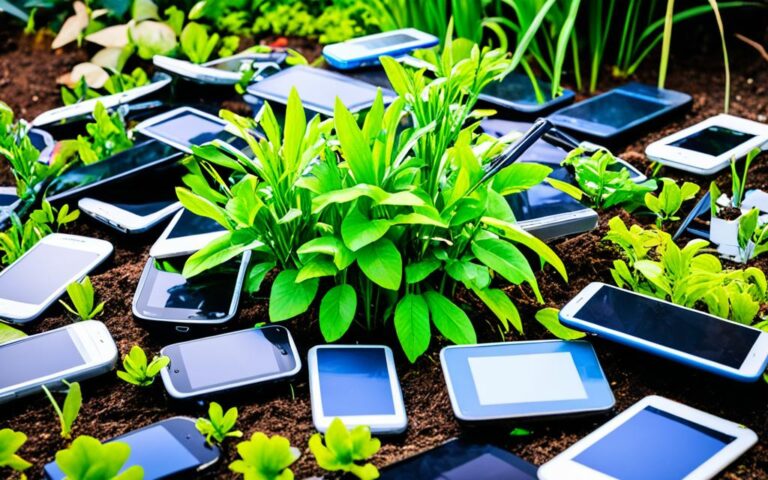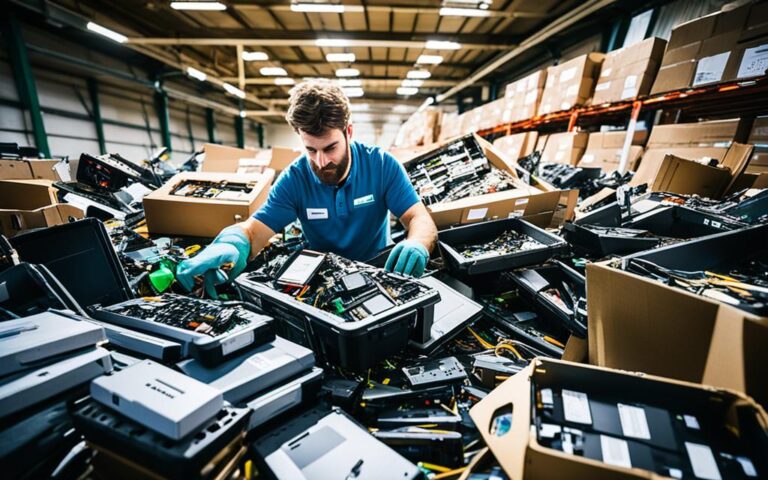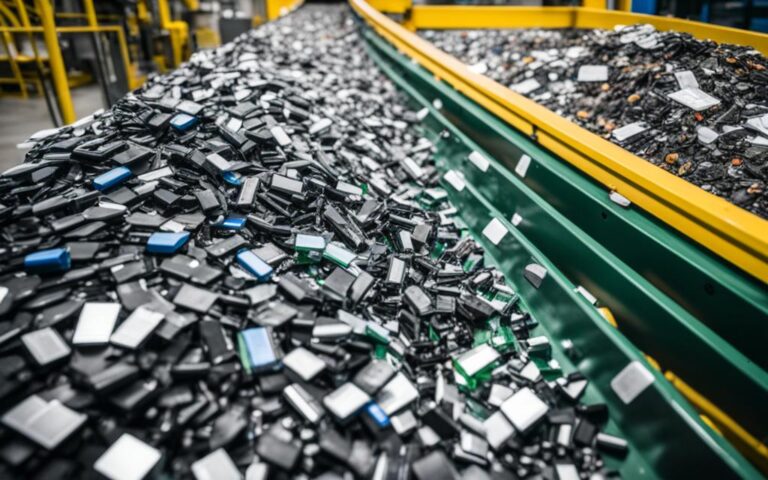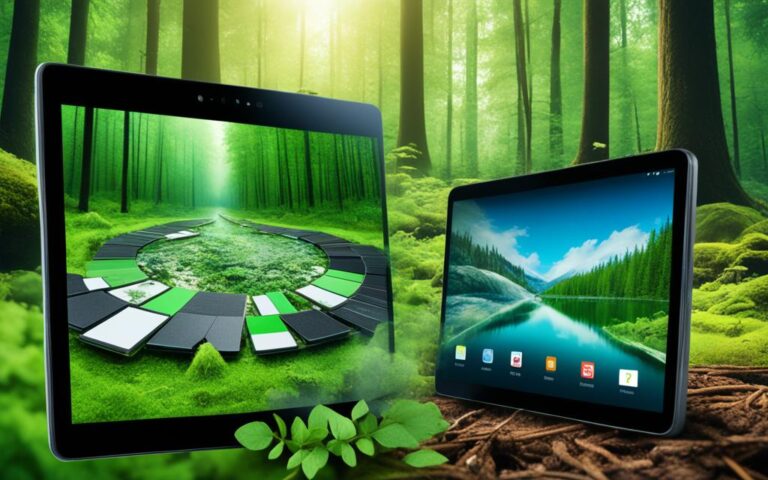The Global Journey of Recycled Phones and Tablets
Welcome to the world of Global Recycled Phones and Tablets, where sustainability and innovation are at the core of our journey. In a rapidly advancing technological landscape, electronic waste (e-waste) has become a pressing issue. However, through recycling and responsible disposal, we can make a positive impact on the environment and create a more sustainable future.
According to a United Nations report, the amount of e-waste generated worldwide continues to rise at an alarming rate. In 2022 alone, a staggering 136.6 billion pounds of e-waste were generated, with only 22% being formally collected and recycled. To tackle this challenge, we need to embrace innovative approaches and global collaboration to ensure that these discarded devices do not end up in landfills, polluting our planet.
The journey of recycled phones and tablets involves various stages, from collection and recycling to the repurposing of valuable components. By giving these devices a new lease of life, we not only minimize the environmental impact but also contribute to a circular economy that promotes sustainability.
Join us on this inspiring journey as we delve into the tragic costs of e-waste, the impact it has on our planet, and explore the future of recycling efforts. Discover how you can make a difference by extending the lifespan of your phones, getting them repaired, and participating in trade-in and recycling programs. Together, let’s take a stand for environmental responsibility and shape a brighter, more sustainable future.
The Tragic Costs of E-Waste
The electronic waste (e-waste) generated in 2022 could fill bumper-to-bumper trucks spanning the equator. However, only a recycling rate of 22.3% was achieved. Experts predict that this rate will further decline to 20% by 2030. E-waste contains hazardous substances such as mercury that pose significant risks to human health.
Most e-waste consists of small items like toasters, while solar panels make up the smallest category. Shockingly, more than 1.1 billion pounds of e-waste are surreptitiously shipped between countries each year under illegal means (United Nations report, 2022).
| Year | E-Waste Generation | Recycling Rate |
|---|---|---|
| 2022 | Enough to fill bumper-to-bumper trucks along the equator | 22.3% |
| 2030 (estimated) | N/A | 20% |
“The amount of electronic waste being generated is alarming. The low recycling rate means that vast amounts of valuable materials and resources are being lost, and hazardous substances are not being properly disposed of,” explains Dr. Emma Johnson, an environmental expert.
The inadequate recycling rate and the widespread shipment of e-waste have resulted in a worsening environmental crisis. Broadcasting this message is crucial to raise awareness about the dire consequences of e-waste mismanagement.
E-Waste’s Impact on Earth
Unmanaged e-waste has a direct and far-reaching impact on the environment and public health. The presence of toxic substances and flame retardants in electronic devices can lead to serious health hazards when inhaled or exposed to. Furthermore, the extraction of materials for electronics production contributes significantly to environmental damage, exacerbating the already alarming state of our planet.
One of the key environmental concerns relating to e-waste is its contribution to CO2 emissions. The production and disposal of electronic devices release a considerable amount of greenhouse gases, including carbon dioxide, into the atmosphere. However, it is essential to note that by efficiently managing the recycling and extraction of resources from e-waste, we can help reduce CO2-equivalent emissions and mitigate their impact on climate change.
Recycling certain types of e-waste can have a significant positive effect on the environment. For instance, recycling refrigerators and air conditioning systems can limit the release of chemicals that thin the ozone layer, contributing to the protection of our planet’s delicate atmospheric balance. By minimizing these harmful emissions, we contribute towards preserving the ozone layer and mitigating the adverse effects of climate change.
| Type of E-Waste | Environmental Impact |
|---|---|
| Refrigerators and Air Conditioning Systems | Reduces release of ozone-depleting chemicals and greenhouse gases |
| Smartphones and Tablets | Reduces resource extraction and associated environmental damage |
| Computer Monitors and Screens | Prevents the release of hazardous substances and reduces landfill waste |
| Batteries and Power Sources | Minimizes the risk of toxic substance leakage into the environment |
By recognizing the far-reaching consequences of unmanaged e-waste, we can take collective action to address this urgent issue. Implementing sustainable practices such as responsible recycling, resource extraction, and reusing electronic devices not only helps protect the environment but also safeguards our health and well-being.
“The environment is where we all meet, where all have a mutual interest; it is the one thing all of us share.”
Lady Bird Johnson
The Importance of Proper E-Waste Management
It is crucial that consumers, manufacturers, and governments work collaboratively to establish robust e-waste management frameworks. By doing so, we can minimize the release of hazardous substances into the environment, reduce health risks, and mitigate the overall environmental impact of electronic waste.
Efforts should be focused on promoting responsible recycling practices and increasing awareness about the environmental consequences of improper e-waste disposal. Moreover, governments and organizations should invest in the development of advanced recycling technologies and facilities, encouraging the efficient extraction and reuse of valuable resources present in electronic devices.
To achieve real progress in combating the environmental impact of e-waste, it is essential that we prioritize sustainability and environmental responsibility in all aspects of electronic device consumption, production, and disposal. Together, we can work towards creating a more sustainable future and protecting our planet for generations to come.
The Future of E-Waste
The increase in electronic waste generation is cause for concern, demanding immediate action to address the environmental impact. To effectively combat this global challenge, the United Nations report emphasizes the need for comprehensive measures that include:
- Recycling Efforts: Increasing the collection and recycling rates of electronic waste is crucial. Governments, businesses, and individuals should actively participate in recycling programs and support initiatives that promote proper e-waste disposal.
- Investment in Infrastructure: To enhance e-waste management, there must be significant investment in infrastructure development. This includes establishing recycling facilities, improving waste disposal systems, and supporting research and innovation in recycling technologies.
- Combating Illegal Shipments: To prevent the detrimental effects of illegal e-waste shipments, stringent measures need to be implemented. Governments should strengthen regulations, enhance international cooperation, and focus on detecting and stopping the illegal transportation of e-waste.
The implementation of these measures can significantly improve the collection and recycling rates of electronic waste by 2030, according to the report. The projected benefits, estimated to surpass $38 billion, highlight the economic and environmental advantages of investing in sustainable waste management practices.
Current Recycling Efforts and Policies
It is essential to recognize that the current state of e-waste recycling efforts and policies requires improvement. Many countries lack comprehensive e-waste policies or have inadequate targets for waste collection and recycling. This highlights the urgency for governments and stakeholders to prioritize and strengthen their commitments to sustainable e-waste management.
By working together, we can create a future where properly recycling electronic waste is the norm rather than the exception. It is through recycling efforts, investment in infrastructure, and combating illegal shipments that we can protect the environment, conserve valuable resources, and pave the way for a sustainable future.
The Environmental Impact of Smartphones
Smartphones have a significant environmental impact, both in terms of emissions and raw material extraction. The production of a new smartphone has a much greater environmental footprint than its actual usage. According to Deloitte, 146 million tons of CO2e emissions were generated by all smartphones in 2022. The internal components of smartphones, which can contain toxic metals, make proper disposal challenging. Extending the lifespan of smartphones and getting them repaired can help reduce their environmental impact.
The Carbon Footprint of Smartphones
When it comes to smartphone emissions, the production process, including mining rare minerals and assembling the device, contributes to a significant carbon footprint. The manufacturing of a single smartphone can release up to 85 kg of CO2e emissions, which is equivalent to driving a car for over 180 miles.
“The production of a new smartphone is responsible for a substantial amount of emissions. As consumers, we need to be aware of the carbon impact and consider the long-term environmental consequences.”
Once a smartphone is manufactured and in the hands of consumers, its usage accounts for only a small fraction of its overall environmental impact. However, the continuous advancements in technology and the demand for new features contribute to a faster turnover of smartphones, resulting in increased emissions from production and disposal.
The Challenge of Proper Disposal
Proper disposal of smartphones is crucial for minimizing their environmental impact. The internal components of smartphones, such as lithium-ion batteries and rare metals like cobalt and tungsten, can contain toxic substances. If not disposed of correctly, these substances can leach into the soil and water, posing risks to ecosystems and human health.
Unfortunately, e-waste recycling rates are still relatively low, and many smartphones end up in landfills or are improperly disposed of, leading to additional environmental damage. It is estimated that approximately 80% of e-waste, including smartphones, ends up in landfills or incinerators.
Extending Smartphone Lifespan
One way to reduce the environmental impact of smartphones is by extending their lifespan. By maximizing the use of a smartphone before replacing it, we can significantly reduce the emissions and resources associated with its production. Repairing a smartphone, rather than replacing it entirely, is a more sustainable approach. Common issues like cracked screens, battery degradation, or software glitches can often be fixed, allowing the device to continue in use.
Repairing smartphones also contributes to the circular economy, reducing waste and extending the lifespan of valuable materials. It can be cost-effective and environmentally responsible to repair smartphones instead of purchasing new ones.
Sustainable Smartphone Recycling
Recycling smartphones plays a vital role in reducing their environmental impact. Proper recycling allows for the recovery of valuable materials and prevents them from entering landfills or being incinerated, which can release harmful substances into the environment.
Many manufacturers and recycling organizations offer smartphone recycling programs where old devices can be dropped off or mailed in for safe disposal. These programs ensure that valuable materials, such as gold, silver, and copper, can be reclaimed and reused in the production of new electronic devices.
Sustainable Smartphone Practices
To minimize the environmental impact of smartphones, consider the following sustainable practices:
- Use your smartphone for as long as possible before replacing it.
- Repair your smartphone instead of buying a new one for minor issues.
- Participate in smartphone recycling programs or donate your old device for proper disposal.
- Consider purchasing second-hand smartphones or refurbished devices.
By adopting these practices, we can collectively reduce the environmental footprint of smartphones and contribute to a more sustainable future.
Making Your Phone Last
Modern smartphones are designed to last longer, and consumers can contribute to sustainability by maximizing the lifespan of their phones. By implementing a few simple strategies, you can extend the usability of your device and minimize electronic waste.
1. Reusing Old Phones
Don’t let your old phone gather dust in a drawer. Instead, consider repurposing it for other uses. Turn it into a dedicated multimedia device for streaming videos or listening to music. Use it as a backup phone or keep it as a spare device for emergencies. By finding alternative functions for your old phone, you can give it a new lease on life and reduce the need for additional electronic devices.
2. Repairing Instead of Replacing
When your phone starts showing signs of wear and tear, resist the urge to replace it immediately. Getting your phone repaired can often solve common issues like cracked screens or battery degradation. Many reputable repair services, such as CPR Cell Phone Repair, offer convenient online repairs that can breathe new life into your device. Additionally, local repair shops can provide reliable and cost-effective solutions.
3. Essential Maintenance Tips
With regular maintenance, you can keep your phone running smoothly for longer. Here are a few tips to maximize your phone’s lifespan:
- Protect your phone with a durable case and screen protector to prevent accidental damage.
- Keep your phone’s software up to date to ensure optimal performance and security.
- Avoid overcharging your phone’s battery, as it can shorten its lifespan. Unplug the charger once the battery is fully charged.
- Manage your phone’s storage by regularly deleting unnecessary files and apps.
“Repair, reuse, make do, and don’t throw anything away.” – Paul McCartney
Remember, your actions can make a difference in prolonging the lifespan of your phone and reducing electronic waste. By reusing old phones, prioritizing repairs, and practicing essential maintenance, you can contribute to a more sustainable future.
| Benefits of Maximizing Phone Lifespan | Reduced Environmental Impact |
|---|---|
| Less electronic waste | Minimization of hazardous materials |
| Cost savings from avoiding frequent upgrades | Decreased energy consumption |
| Extended usage for alternative purposes | Lower carbon emissions |
Recycle or Resell Your Phone
When it’s time to dispose of your old phone, consider recycling or reselling it instead of throwing it away. Improper disposal of electronics can contribute to the growing problem of e-waste, endangering the environment and human health. By opting for responsible recycling or reselling, you can help reduce e-waste and make a positive impact.
There are several reputable companies that offer phone reselling programs, allowing you to give your old phone a second life and earn compensation in the process. Companies like Decluttr, Gazelle, Swappa, and SellCell provide convenient platforms where you can get an estimate for the value of your phone and easily send it in for resale. This not only helps you recoup some of the phone’s value but also ensures that it is reused by someone else instead of ending up in a landfill.
Another option to consider is the trade-in programs offered by mobile carriers and retailers. Many well-known companies like AT&T, Verizon, T-Mobile, Best Buy, Samsung, Apple, and Amazon offer trade-in programs that allow you to exchange your old phone for credit towards the purchase of a new one. This is not only a convenient way to upgrade your device but also encourages proper recycling and reduces e-waste.
Benefits of Recycling and Reselling Your Phone
“By recycling or reselling your phone, you can help protect the environment, reduce electronic waste, and contribute to a more sustainable future.”
By choosing to recycle or resell your phone, you are making a conscious choice to be environmentally responsible. Here are some key benefits:
- Environmental Impact: Recycling and reselling phones helps reduce the amount of electronic waste that ends up in landfills. It prevents hazardous materials and toxic substances found in phones from polluting the environment and harming ecosystems.
- Resource Conservation: Recycling phones allows valuable materials such as precious metals and rare earth minerals to be recovered and reused in the production of new devices. This reduces the need for extracting finite resources from the earth.
- Economic Opportunities: The phone reselling market creates employment opportunities and stimulates the economy by supporting a circular economy model. It enables individuals and businesses to benefit financially by extending the life of used devices.
To summarize, recycling or reselling your phone is a win-win situation. It not only helps in the reduction of e-waste but also presents an opportunity for you to contribute to a more sustainable future. Consider recycling or reselling your old phone today and make a positive impact on the environment.
| Recycling or Reselling Your Phone | Benefits |
|---|---|
| Reselling | Earn compensation for your old phone |
| Recycling | Prevent e-waste and protect the environment |
| Resource Conservation | Reuse valuable materials and reduce resource extraction |
| Economic Opportunities | Create jobs and stimulate the economy |
Conclusion
The journey of recycled phones and tablets is crucial for achieving sustainability and minimizing the environmental impact of electronic waste. It is our responsibility to prioritize sustainable phone practices and embrace environmental responsibility. By adopting proper disposal methods, engaging in recycling initiatives, and making responsible choices when reselling our old phones, we can contribute to the preservation of our planet.
Extending the lifespan of our phones by getting them repaired and participating in trade-in and recycling programs is essential. These actions not only reduce waste but also help in reducing carbon emissions and conserving valuable resources. Additionally, supporting initiatives that promote the circular economy and minimize e-waste can have a lasting positive impact on our environment.
Every individual has the power to make a difference. Let’s choose sustainable phone practices and take environmental responsibility seriously. Together, we can create a more sustainable future for generations to come.
FAQ
What is the global journey of recycled phones and tablets?
The global journey of recycled phones and tablets involves proper disposal, recycling, and responsible reselling to reduce the environmental impact of electronic waste and promote sustainability.
What are the tragic costs of e-waste?
The tragic costs of e-waste include a low recycling rate, with only 22% of e-waste generated worldwide being formally collected and recycled. E-waste contains hazardous substances and poses a risk to human health and the environment.
How does e-waste impact the Earth?
E-waste has a direct impact on the environment and public health. Toxic substances and flame retardants found in screens and monitors can be harmful when inhaled, and the extraction of materials for electronics production contributes to environmental damage.
What is the future of e-waste?
The future of e-waste depends on improved recycling efforts, investment in infrastructure development, promotion of repair and reuse, and measures to stop illegal e-waste shipments. These measures, if implemented, could improve collection and recycling rates by 2030.
What is the environmental impact of smartphones?
Smartphones have a significant environmental impact, both in terms of emissions and raw material extraction. The production of a new smartphone has a greater environmental footprint than its actual usage, and improper disposal of smartphones can contribute to e-waste.
How can I make my phone last?
By maximizing the lifespan of your phone, you can contribute to sustainability. Using old phones for other purposes and getting them repaired instead of replacing them can help extend their usefulness and reduce their environmental impact.
Should I recycle or resell my phone?
Recycling or reselling your phone is the best option for proper disposal. Improper disposal of electronics can contribute to e-waste and harm the environment. Many companies and trade-in programs offer options for reselling or recycling your phone.
What is the conclusion on sustainable phone practices?
Prioritizing sustainable phone practices such as recycling, reselling, and extending the lifespan of phones can contribute to a more sustainable future. It is important for individuals to make environmentally-friendly choices and support initiatives that minimize e-waste.


